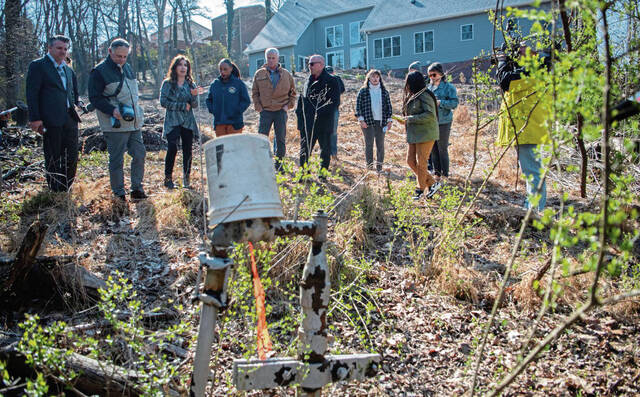Murrysville abandoned gas well to be plugged; state officials assessing thousands more
When Pamela Schrank’s family moved into their Murrysville home last May, she was told an old gas well at the edge of some woods on their property had been capped.
That wasn’t the case, according to state environmental officials — a fact Schrank found out last fall when she was walking her dog near the well and detected an odor associated with escaping methane.
“I smelled the gas, and I got so dizzy I almost fainted,” Schrank said. “It was so overpowering because it was a hot day. That’s when I panicked and went inside and called the gas company.”
Between the gas utility and municipal officials, Schrank learned the well on her Benden Circle property is one of tens of thousands of abandoned gas and oil wells the state Department of Environmental Protection believes are dotting Pennsylvania’s terrain.
A conventional orphan gas well from the early 1900s, for which ownership can no longer be documented, it’s one of about 70 abandoned wells initially targeted to be filled with cement and capped as part of an upcoming round of federal funding.
It’s one of a handful of such wells in the area that DEP expects will be plugged this summer by a contractor yet to be determined.
“I really need this to be taken care of as soon as possible,” Schrank said Thursday after DEP officials and U.S. Rep. Summer Lee, D-Swissvale, stopped to view the well.
“This is a dandy,” Cliff Simmons, DEP oil and gas inspector supervisor, said of the well.
Factors that mark the well for priority attention, he said, include its location within 200 feet of the Schrank house and the fact it is corroded and leaking methane — a greenhouse gas the Environmental Protection Agency notes is more than 28 times as potent as carbon dioxide at trapping heat in the atmosphere.
“It can also be dangerous if it’s in a confined space,” Dan Counahan, director of DEP’s district oil and gas operations, said of methane. “It’s an explosive hazard.”
The salty brine water byproduct or oil leaking from a well also can have a harmful effect on the environment, he said.
Depending on the condition of an abandoned gas well, its surroundings and buildings in the vicinity, it might have the potential to leach methane into nearby streams, private water wells or basements, officials indicated.
At the Schrank property, Simmons said, “The fact that this is leaking (methane) is kind of a good thing, in that the gas is coming to the surface and being dissipated. Unless you did something right at the well, chances are you don’t really have a real problem with an explosion.
“Had this well been sealed at the surface, you could have problems underground. That’s usually where the problems start, when the gas starts migrating under the ground.”
Lee expressed concern about the potential problem of benzene occurring at abandoned wells. She referred to a May report on a study of 43 such wells in Western Pennsylvania that detected the presence of compounds including the carcinogen.
DEP officials acknowledge the state faces a daunting task in attempting to address Pennsylvania’s plethora of abandoned wells. Officials are aware of about 27,000, but they estimate there are another 350,000 that haven’t been documented.
The department had been spending about $1 million annually on plugging such wells, Counahan said. He said that effort ramped up last year, thanks to $25 million received through the federal Infrastructure Investment and Jobs Act.
With an average cost of $100,000 per well, he said, “Since January of last year, we’ve plugged more wells than in the nine previous years.”
That figure can be inflated by the cost of gaining access across private property for the heavy equipment needed to plug wells and then restoring the affected land.
Schrank’s well should be among the first batch to be addressed with additional well-plugging dollars DEP is expecting through IIJA: $76 million per year over the next four years.
As the DEP plugs known abandoned wells, it will be keeping an eye out for additional ones nearby that need attention.
Don Hegberg, oil and gas program manager, said DEP also has applied for another $44 million in federal funding that would be offered in grants to active well operators. As prioritized and determined by the DEP, that money would help to contain some of Pennsylvania’s estimated 69,000 underperforming conventional gas wells — those producing less than 15,000 cubic feet of gas per day.
Researching old paper trails and mining maps can go only so far in identifying more abandoned wells. Other steps DEP may take include aerial surveys to spot methane plumes and scanning for the presence of metal in wooded areas.
“One of our best resources is the public,” Simmons said, noting it helps when property owners such as Schrank report an odor of gas to 911 or discover potential well equipment on their land and notify DEP.
“We’ve been fielding quite a few calls,” he said.
Lee said she’s hoping a bipartisan bill she helped to introduce will assist with plugging abandoned wells.
“Both parties are recognizing this issue,” she said. “This seems like a monumental task.”
The Bipartisan Abandoned Well Remediation Research and Development Act would create an abandoned wells research, development and demonstration program at the Department of Energy. The bill passed unanimously through the Committee on Science, Space and Technology in September and is awaiting a vote by the full House.
Jeff Himler is a TribLive reporter covering Greater Latrobe, Ligonier Valley, Mt. Pleasant Area and Derry Area school districts and their communities. He also reports on transportation issues. A journalist for more than three decades, he enjoys delving into local history. He can be reached at jhimler@triblive.com.
Remove the ads from your TribLIVE reading experience but still support the journalists who create the content with TribLIVE Ad-Free.







